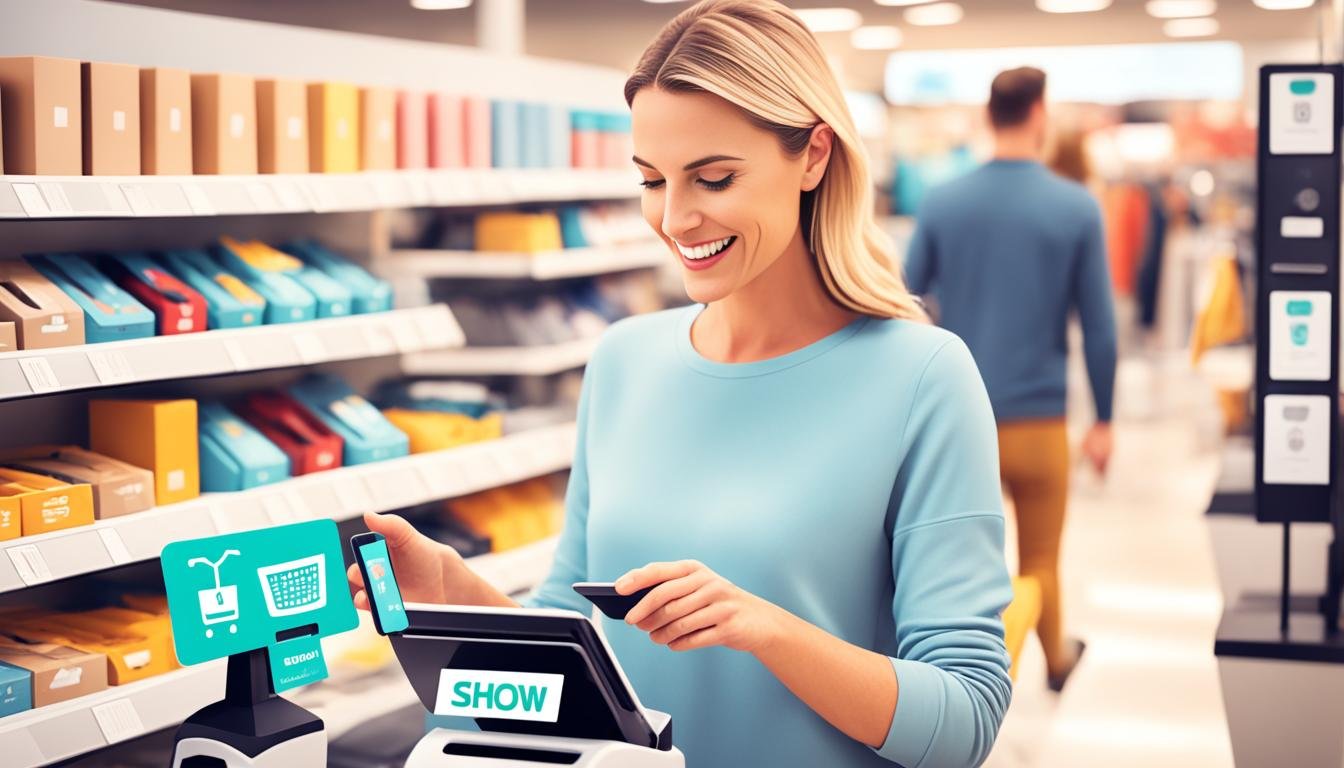Seamless Shopping: The Importance of Unified Omnichannel Experiences in 2024
Have you ever noticed how some stores offer a consistent shopping experience across their website, app, and physical store? This is thanks to omnichannel retailing. It changes how businesses talk to customers by linking all shopping channels for a single experience.
In today’s fast-paced shopping world, the importance of unified omnichannel experiences in 2024 is huge. Shoppers expect to move easily between online and in-store, without missing a step. Companies that offer seamless shopping make customers happier, more loyal, and spend more. In fact, studies show that strong omnichannel strategies keep about 91% of customers.
Looking forward, omnichannel strategies will change what makes a store successful. Brands that don’t use these strategies might fall behind. But those that do could lead the way in seamless shopping experiences by 2024.
Key Takeaways
- Omnichannel strategies retain an average of 91% of customers.
- Seamless shopping experiences enhance customer loyalty and repeat purchases.
- Integrated customer journeys bridge online and offline channels for a consistent brand experience.
- AI and real-time data integration play crucial roles in improving customer experiences.
- Adoption of omnichannel ecommerce is key to capturing leads, converting prospects, and maintaining customer loyalty.
Understanding Omnichannel Retailing
Omnichannel retailing is a way to connect different shopping channels for a smooth and personal shopping experience. It brings together physical and online stores, making sure customers have a consistent brand experience everywhere. This includes everything from in-store visits to online shopping and social media.
Definition and Scope
Omnichannel retailing means making all retail operations work together as one. It uses a single platform for everything, managing data better and improving how it talks to customers. This approach covers all ways customers interact, like in-store, on mobile apps, or through emails.
Key Features and Benefits
Using a unified commerce platform has many benefits:
- Consistent and Seamless Experience: Customers want a smooth journey across all channels. In fact, 79% of people want brands to have the same messages and looks everywhere online.
- Data Centralization: By linking different touchpoints, companies can better understand and use customer data. This helps in making marketing more personal and effective. For instance, Hornby Hobbies saw a 10% increase in website sales and a 34% rise in email revenue by going omnichannel.
- Enhanced Customer Experience: A unified customer experience is key. With 90% of American shoppers looking at shipping costs and speed, having a strong logistics system is vital.
Switching to an omnichannel strategy can really boost a brand. Big names like Amazon, Apple, and Nike have done this and seen more loyalty and engagement. As more companies follow this path, they’ll likely see happier customers and more people sticking around, leading to growth and profits.
Omnichannel vs Multichannel: What’s the Difference?
In today’s market, knowing the difference between omnichannel and multichannel marketing is key. Both methods use various platforms to reach customers. But, they differ in how they do it, affecting the customer’s experience.
Integrated Customer Experience
Omnichannel retail aims for a integrated customer experience at every touchpoint. It makes sure all platforms, from online to in-store, work together for a smooth shopping journey. Brands like Nike and Disney have grown and gained loyal customers by using omnichannel strategies.
Nike boosted its digital sales by 35%. Disney built a strong community first, then expanded its retail presence.
Separate vs Unified Data
One big difference is how they handle data. Multichannel marketing uses data separately for each channel, leading to a broken customer experience. This can make shopping frustrating for customers.
On the other hand, omnichannel retail puts all data together. This gives businesses a full view of customer journeys.
With unified data, personalization gets better, and inventory and fulfillment become more flexible. Brands like Starbucks and Allbirds use this to make shopping smoother across all channels. This leads to more sales and keeps customers coming back.
Developing an Effective Omnichannel Retail Strategy
Creating a strong Omnichannel Retail Strategy needs careful planning and knowing your customers well. First, understand what your customers want and need. Then, find all the places where they might interact with your brand. Make sure their experiences are the same across all platforms.
Understanding Customer Needs
Start by knowing what your customers want and need. Use Customer Journey Mapping and make customer personas to tailor experiences. This makes sure the experiences match what customers expect, making their journey better.
Identifying Touchpoints
Good Customer Journey Mapping means finding every interaction between customers and your brand. These can be social media, in-store visits, or online shopping. Knowing where customers meet your brand helps make moving between channels smooth.
Creating Consistent Experiences
Being consistent is crucial in an Omnichannel Retail Strategy. Brands should have the same experience at every touchpoint. Training teams and using real-time data to meet customer needs makes shopping better. Also, solving problems like data silos and supply chain issues is key for a smooth omnichannel presence.
According to market data:
- Customers who shop across channels spend more over time, showing bigger transactions and more customer value.
- Companies with strong omnichannel retail strategies keep about 89% of their customers, while others keep only 33%.
- BOPIS (buy online, pick up in-store) sales go up by 35% during the holidays.
By focusing on these areas, businesses can make an omnichannel strategy that goes beyond what customers expect. The main goal is to give consistent brand experiences that connect with customers, build loyalty, and lead to long-term success.
The Role of Technology in Omnichannel Experiences
In today’s fast-changing retail world, technology is key to great omnichannel strategies. Brands use immersive shopping tech to give customers smooth interactions across all platforms.
AI and Machine Learning
Machine learning and AI in omnichannel retail make shopping personal by looking at lots of data. These tools help brands suggest products, manage stock, and guess future trends. Features like visual search and changing prices make shopping easy, making them vital for success.
Real-Time Data Integration
Real-time data integration is crucial for knowing what customers want and managing stock well. It combines data from different places to make a single customer view and send out targeted ads. It also keeps stock levels the same everywhere, reducing the chance of running out of items.
Mobile-First Experiences
With more people using mobiles, mobile-first experiences are now a must. Retailers are making mobile apps with easy navigation, safe payment ways, and personal product tips. This focus makes users happy and boosts sales.
To sum up, using immersive shopping tech, AI in omnichannel, and focusing on mobile-first experiences and real-time data is key for great omnichannel retail. Retailers that use these techs are likely to do well in the competitive market.
Seamless Shopping: The Importance of Unified Omnichannel Experiences in 2024
The future of shopping is all about unified omnichannel experiences. Today, 73% of shoppers use different channels to shop. This means businesses must offer smooth shopping experiences to keep up.
Companies like Bidfood and Autoglym UK have blended online and offline shopping. This has made customers happier and boosted sales. In fact, 80% of retailers think combining channels is key to selling more.
Technologies like AI and machine learning help make shopping smooth. Personalized suggestions and special deals have led to a 30% sales jump for many stores. Self-service kiosks and mobile payments also make shopping faster and easier.
Now, people care more about experiences than things. About 75% of young people, especially millennials and Gen-Z, prefer experiences over goods. This makes in-store experiences more important, drawing in 40% more customers.
Also, 90% of retailers see unified shopping as a way to stand out. By using these strategies, companies can make customers happier and more loyal. For example, asking for feedback has made customers 15% happier and 35% more loyal.
But, there are challenges like data issues and not having the right tech. Working with experts like a Magento Ecommerce Agency can help overcome these problems. This ensures businesses can make the most of unified shopping experiences.
Personalization in E-commerce
In today’s digital world, making e-commerce personal is key for businesses. It helps improve customer experiences, boost engagement, and increase sales. By using data, businesses can understand what customers like and give them what they want.
Data-Driven Personalization
Using AI and machine learning, brands can analyze lots of data. This helps them predict what customers will like and do. They can then offer personalized recommendations and marketing that really speaks to each shopper.
Companies like Yves Rocher and Mansion Group use AI to make shopping better. They give customers content and offers that match their interests. This has made customers happier and more loyal.
Improved Customer Loyalty
Personalization is key to keeping customers coming back. When brands send emails and offers that feel just right, customers stick around. This means they buy more and come back often.
Brands that make shopping smooth and personal across all platforms keep customers for longer. This leads to more time on websites, more sales, and happier customers.
BOPIS and Curbside Pickup
BOPIS (Buy Online, Pick Up In-Store) and curbside pickup are changing how we shop. They offer more flexible shopping options. Before the pandemic, only a few big stores had these services. Now, 44 percent do.
BOPIS and curbside pickup cut down on shipping costs and delays. They give customers quick access to what they need. The BOPIS market was worth nearly 244 billion USD in 2021. It’s expected to go over 700 billion USD by 2027.
US consumers will spend about 96 billion USD on BOPIS in 2022. This shows how much people rely on these flexible shopping options.
Retailers gain a lot from BOPIS and curbside pickup. They increase sales and make customers happier. Most orders are ready for pickup within an hour, showing how efficient these services are.
These services need good order processing and inventory management. They also need clear communication with customers about how to pick up their orders.
Kibo Commerce can set up curbside pickup in just 30 days. This shows how important it is to be quick and have good digital systems.
Even though things are getting back to normal, BOPIS and curbside pickup are here to stay. They are convenient and efficient. Retailers need to keep improving and making these flexible shopping options part of their plans to meet what customers want.
Social Commerce and Influencer Marketing
In 2024, online shopping is changing fast with social commerce on the rise. Now, people can buy things directly on social media sites like Instagram, TikTok, and Facebook. A big group (23.1%) of US shoppers aged 25 to 34 are buying more on social platforms.
Influencer marketing is key to reaching more people and building trust. It uses social media stars to make shopping more personal and fun. This mix of social commerce and influencer marketing helps brands stand out.
Strategies like influencer takeovers and live events work well to boost sales. Sephora uses influencer marketing to grow online and offline, getting great results.
Social commerce is booming: it’s expected to hit $80 billion in the US by 2025 and $2.9 trillion worldwide by 2026. Facebook leads with 62% of US buyers making purchases there. TikTok is growing fast, with 48.8 million US users by 2025. Brands using social media and influencers get more engagement and sales.
For brands, combining influencer marketing with other strategies like email and SEO is key. Social media users spend a lot of time on their favorite apps, giving brands a chance to connect and convert customers.
As social commerce and influencer marketing merge, brands that use both well will lead in e-commerce. They create shopping experiences that fit what today’s shoppers want.
Leveraging Predictive Analytics in Retail
In today’s fast-changing retail world, predictive analytics is key. Retailers use it to stay ahead in the game. It helps make shopping more connected and efficient.
This tool lets retailers guess what customers want, manage stock better, and work smarter. By using advanced algorithms, they turn complex data into useful insights.
Demand Forecasting
Demand forecasting is a big part of predictive analytics. It uses past data to guess what customers will want in the future. This helps retailers keep the right items in stock, avoiding too much or too little.
Companies like Amazon are great at this. They make sure products are available when customers want them. This makes customers happy with fast and reliable service.
- Optimizes inventory levels
- Reduces costs associated with excess inventory
- Improves customer satisfaction by meeting demand
Customer Behavior Insights
Predictive analytics also sheds light on customer behavior. It shows how people shop, what drives them to buy, and what influences their choices. This helps retailers craft marketing that really speaks to their audience.
Companies like Nike and Apple use AI to make shopping more personal. They use data to grab attention and build loyalty. This approach is set to grow as more retailers see the benefits of predictive analytics.
Virtual and Augmented Reality in Shopping Experiences
Technology is changing how we shop, thanks to virtual reality shopping and augmented reality retail. These new tools are making shopping better in stores and online.
Enhancing In-Store Experience
Retailers are using augmented reality to make shopping more fun. With AR mirrors, customers can try on outfits virtually. This makes shopping more personal and efficient.
AR also helps customers see how furniture would look in their homes. This lowers the chance of returns and makes buying decisions more confident.
Virtual Try-Ons
Virtual try-ons are changing online shopping. They let customers try products without leaving home. This closes the gap between shopping online and in person.
These try-ons make shopping more personal and engaging. They also help increase sales. This meets what shoppers want from a smooth shopping experience across all platforms.
Sustainability and Omnichannel Retail
Sustainability is now key in omnichannel retail, thanks to more eco-aware consumers. Retailers are making eco-friendly shopping experiences a big part of their plans. Most retailers are either already using or planning to use omnichannel strategies, showing how important it is to be sustainable across all platforms.
Businesses are focusing on eco-friendly packaging, sustainable supply chains, and recycling. These efforts help shape what customers buy and keep them coming back. Big names like Amazon and Walmart are leading the way with their sustainability efforts, proving you can be profitable and green.
Retailers are using tech to make eco-friendly shopping experiences better. They’re investing in mobile-friendly websites and apps for easy shopping anywhere. The pandemic has made online shopping more popular, pushing retailers to improve their omnichannel strategies.
Now, customers can find more products online, making it harder for retailers to stand out. But, the omnichannel approach brings in 80% of in-store visits, showing its power. It also helps manage inventory better, making customers happier.
Having all data in one place gives retailers insights into what customers want and market trends. This helps them offer personalized shopping experiences. In 2024, focusing on the customer is key to success, boosting engagement and loyalty.
Retailers need to stay ahead by training staff and listening to customers. This keeps their sustainability efforts strong. By focusing on sustainability, retailers and eco-aware customers both win.
Conclusion
The future of omnichannel retailing looks bright, with a market growth to USD 18.8 billion by 2030. This growth rate is 13.8% from 2022 to 2030. Customers now expect consistent interactions across all channels, making a unified shopping experience crucial.
Businesses that use omnichannel strategies see big wins. They enjoy 10% growth each year, a 10% increase in average order value, and a 25% rise in close rates. Brands like H&M and Lenskart show how to blend online and offline well. They prove that a strategic approach can boost customer satisfaction and profits.
The future of omnichannel retailing focuses on personalization, technology, and sustainability. Using predictive analytics, AI, and machine learning helps retailers meet customer needs. This approach increases customer lifetime value by 30% for some businesses.
Brands that focus on a seamless, omnichannel experience will lead the market. They build customer loyalty and drive growth. This approach is key to success in today’s retail world.
Source Links
- Omnichannel Ecommerce: Seamless Shopping In 2024
- From Omnichannel to Unified Commerce: Elevating Retail in 2024
- 7 Omnichannel Trends to Watch in 2024: Boosting Profit with Seamless Shopping Experiences
- Exploring Omnichannel Retail Trends in 2024: A Practical Guide
- Revolutionizing Retail With Seamless Omnichannel Shopping
- Omnichannel Retail Trends for 2024
- Omnichannel vs. multichannel 2024: What’s the difference and who is doing it?
- Understanding Omnichannel Vs Multichannel Marketing for Success
- Omnichannel vs Multichannel: What is the Difference? (2024) – Shopify
- The Secret to a Successful Omnichannel Retail Strategy in 2024
- 4 Omnichannel Trends for Retail in 2024
- Omnichannel retail and the seamless shopping experience
- Omnichannel Retail: Seamless Shopping Experience — Katana
- What It Is and Best Practices for 2024
- The Future of Shopping: How to Create a Seamless Retail Experience That Drives Sales and Customer Loyalty
- Creating Seamless Omnichannel Experiences: Strategies for Unified Customer Journeys – iWeb Ecommerce Partner Agency
- E-commerce Success in 2024: The Crucial Role of Personalization
- 2024 Omnichannel Commerce Trends | Monetate
- Unified Commerce: The Future of Seamless Shopping (2024) – Shopify
- The Future of BOPIS and Curbside Pickup | Kibo Commerce
- The Future of Retail: Enhancing the Customer Experience in 2024
- The Rise of Omnichannel Influencer Marketing
- What is Social Commerce? Trends and Key Insights for 2024 – Shopify
- Exploring Retail Omnichannel Trends 2024: Navigating the Future
- 15 Impressive Retail Trends You Need to Know in 2024
- Omnichannel Strategies in 2024: What to Expect – EYStudios
- Marketing 2.0 Conference
- Omnichannel Retail: All You Need to Know for 2024 – ContactPigeon | Blog
- Unified Experiences: Why Omnichannel is the Future of Business – Upshot.ai
- 2024 State of the retail consumer | eBook Conclusion | Cart.com







